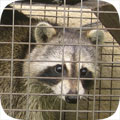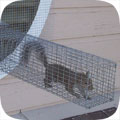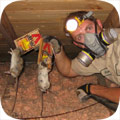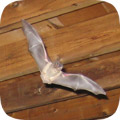If you are having a problem with wildlife in your Binghamton home, your best option is to hire a company that specializes in New York wildlife removal only. This is a specialty business, and regular
pest control companies do not use the proper techniques to solve animal problems. I have spent many years reviewing Binghamton, and I recommend the following:
Fur and Feathers Wildlife Control
Cell Phone: 607-353-6330
NOTE: If you have a dog or cat problem, call Broome County Animal Services: (607) 724-3709

Fur and Feathers Wildlife Control specializes primarily in removing animals from attics of homes and buildings - this includes squirrels in attics, raccoons, and rats
or mice in homes. New York also has a documented problem with
bats in buildings, and Fur and Feathers Wildlife Control is specially trained in bat removal. They also perform general wildlife trapping services, such as the capture and removal of skunks or opossums on the
property. Call
607-353-6330 to discuss your critter problem and schedule a same-day or next-day appointment.
When hiring a company to solve your wild animal problem, you want these features:
- Specializes in wildlife removal, not pest control
- Fully New York and Broome County licensed and insured
- Works 7 days per week (critters don't take weekends off)
- Performs full building inspections: enters and inspects attic
- Performs exclusion repairs, with guarantee against animal re-entry
- Offers cleanup of biohazardous wildlife waste
Fur and Feathers Wildlife Control is a full-service Binghamton wildlife removal company. This is very different from a regular Binghamton pest control company. The pest control companies spray poison to kill insects. This is not at all
similar to wildlife removal. Fur and Feathers Wildlife Control performs a full inspection of the home or property, and determines why the animal(s) are there, and if inside a building, how the animals got inside. All
animals (including rodents) are trapped and removed, or if possible, removed from the building using special exclusion devices. Once the animals are gone, preventative repairs are essential, and
cleanup is sometimes recommended.
 | |
Binghamton wildlife trapping - it's not as simple as it may seem. It's illegal in New York to trap without a license. Trap type is very important and there are many different types, bait is somewhat relevant, trap placement
is vital, and there are dozens of small things that are very important to know.
Safety is a concern. Then once the animal is trapped, it must be removed and dealt with in the proper manner according to New York law. We offer Binghamton raccoon removal. Read more about how to get rid of raccoons.
|
 | |
Animals in attics - this is our specialty at Fur and Feathers Wildlife Control. Many types of animals like to live in attics. This includes squirrels, raccoons, rats, mice, bats, birds, and even possums. Critters like to go into attics for a safe place to live
and raise their young. Removing animals from attics is very complex work, partly because of the presence of baby animals. If you need Binghamton squirrel removal, we can remove all the squirrels from your attic, and seal out any future ones. Read more about how to get rid of squirrels.
|
 | |
Rodent control must be done in a very specific way. First off, the most important thing is that all the openings that rats and mice can use to enter a house be sealed. Then all the rodents must be physically trapped and removed.
Never, ever use poison! Most Binghamton exterminators will just use this lazy poison technique to kill rodents, and it causes more harm than good - dead stinky rats, and it doesn't solve the problem. Call us for correct Binghamton rat removal. Read more about how to get rid of rats.
|
 | |
Bat removal is a highly specialized task. New York is known to have colonizing bats who often live in buildings. Bats love attics. If not removed, the colony can grow to a very large size over the years. The bat droppings are often corrosive and
cause health risks. The same goes for bird droppings on or in buildings. We perform Binghamton pigeon removal and bird control. But our specialty is Binghamton bat removal. We remove 100% of the bat colony and seal the building so that it's totally bat-proof. Read more about how to get rid of bats.
|
 | |
If you have animals inside a house, no job is complete without proper exclusion repairs. If you simply hire a Binghamton trapper who only removes the critters, then the problem will return. You need to hire a Binghamton wildlife control company that identifies 100% of the animal entry points
into your building, and seals them shut with professional repairs. In addition, in many cases animals have left waste or contamination behind, and you'll want a company that can provide professional cleaning services. Fur and Feathers Wildlife Control does both.
|
The above are just some of the services offered by Fur and Feathers Wildlife Control. We also trap and remove animals that destroy lawns, such as moles, or digging animals. Sometimes animals like opossums will live under buildings, steal pet food, raid garbage cans, etc.
Read about
how to get rid of opossums. Skunks commonly live under sheds or decks, and set up a den. We can trap and remove them without them spraying. Read about
how to get rid of skunks. Fur and Feathers Wildlife Control
also provides dead animal removal in Binghamton. If you need help with any other wildlife conflict, from a fox, beaver, groundhog, or any other critter, we can solve it. We also do Binghamton snake removal - most of the snakes in New York are not venomous, but
call us if you want safe removal, or read about
how to get rid of snakes in Binghamton. And remember, we are a private business, not Broome County Animal Control Services, so if you have a dog or cat problem, call the County at (607) 724-3709.
Broome County animal services does not handle any wildlife issues.
Fur and Feathers Wildlife Control
Cell Phone: 607-353-6330
Binghamton Wildlife Tip #1:What time does nocturnal wild animal go out to get food? - In order to effectively remove the nocturnal wild animal problem from your house, let's say for example, it's currently claiming squatter's rights in your attic, you must have some useful bits of information. These animals are smart - they have been around since the age of the dinosaurs after all! One of the most useful things that you can learn about the nocturnal wild animal is the time at which they go out to feed - this will essentially better help you to set traps, figure out when to block entrances and exits, and generally start on your plan to remove the annoying creature from your attic. Take a look at the sounds that you hear noise from the nocturnal wild animal - it's usually when you are in bed. This gives you some idea of when they are most active. They are nocturnal creatures by nature, although they are venturing out in daylight hours more and more these days, especially as they seem to becoming rather used to people and rural living. However, you will often find that your friendly nocturnal wild animal will wake up at around 9pm, potter out to work, (as in search for food) at around 9/10pm, and then head home for a good night's sleep at around 4am. This gives you plenty of time to block exits, work out where they are getting in and out from and set traps in the right areas. Your main priority at this time may be evicting the nocturnal wild animal completely from your property, but in actual fact by doing this, you are just encouraging other nocturnal wild animals and wild animals to come running. Rather than looking at getting rid of the animal completely, why not consider placing a nest box at the end of your yard? This gives the animal somewhere that it is "allowed" to live, and it will help remove the problem from your attic at least!
Binghamton Wildlife Tip #2:Humane wildlife removal raccoon - There are no robots out there that have yet been used in animal removal, though some of the technologies seen for the Mars Rover are pretty impressive. A machine lacks the fine motor skills and reasoning ability of a human and is still inferior to a human when it comes to many things. Because handling animals requires care and attention to changing details, the human touch is almost always necessary. You can capture a nuisance raccoon in a humane way, without the use of traps like leg holds or body gripping devices. In fact, if you can find and remove the raccoon's babies while the mother is out, you can use the young to lure the mother into a trap. This should only be done while you can monitor the infants; you don't want them exposed to the elements and predators for too long. Never leave babies outside in the heat of the day. If you don't like the idea of using the kits as a lure, trapping the raccoon can be done using a cage trap and some marshmallows. Raccoons are opportunistic feeders, and while they like meats and fruits, using bread or a marshmallow will ensure you don't accidently trap another pest animal like an opossum.
New York Wildlife Information:New York State State bird: Eastern bluebird
State mammal: Beaver
State amphibian: Wood frog
State fish: Brook trout and striped bass
State insect: 9-spotted ladybug
State reptile: Common snapping turtle
New York, the Empire State, has a diverse population of animals, attributed to the state's variety of landscapes and wide range of temperatures. Not only are there heat-loving animals in New York, like snakes, frogs, and turtles, there are a good number of animals just as oriented to survival in cold weather, like wolves, bear, and deer. Most of these cold-to-warm critters have adaptations not seen in other states. White-tailed deer, for example, will store fat and develop thick coats for the cold season, whereas their cousins in the warmer southern states have no need for such an improvement. If winter is too much for an animal in New York State, it either enters of form of hibernation or it migrates. This is true for the numerous bats, woodchucks, geese, amphibians, and snakes in the area.
People who aren't from New York often associate the state with the large city that shares its name. New York City, though it houses the majority of people in the state, is just a small part of the landscape. Upstate New York, which can be rural or urban, is far larger, and has the bulk of wildlife New York is known for.
Unfortunately, because New York is widely populated with the exception of the Adirondack Mountains, most of the animals in the state have the potential to become nuisances. Residents have their fair share of raccoon, opossum, skunk, and woodchuck invasions every year. Beaver, though not as densely populated as they once were, number in the hundreds of thousands. These creatures are not terribly problematic unless homeowners live near bodies of water that are being flooded or drained due to beaver activity. Some landscape damage from tree-felling is also characteristic of this wood-loving critter. While beaver, skunks, squirrels, and woodchucks aren't predatory to people, there are a number of dangerous wild animals in New York that can become pests. The number one problem predator is the coyote. Because of a population boom, this canine has spread to both urban and rural areas, killing pets and livestock, posing a threat to small children. Coyotes are also common carriers of rabies in the state along with skunks and raccoons.
When it comes to rabies, however, bats are still the number one species for infection in New York. There are thousands of confirmed animal rabies cases in the state every year, and the Department of Environmental Control took to vaccinating the animal population with vaccine-doctored food blocks dropped into the wild by way of helicopter.
You can always call Fur and Feathers Wildlife Control, any time of day, at 607-353-6330, for a price quote for Binghamton wildlife control services. I am confident that this is the best choice amongst wildlife removal companies in Binghamton, NY.